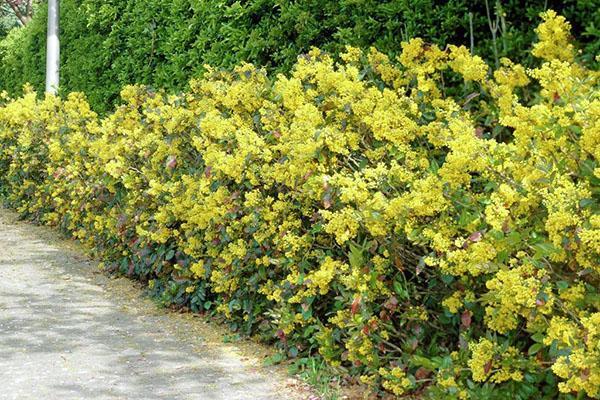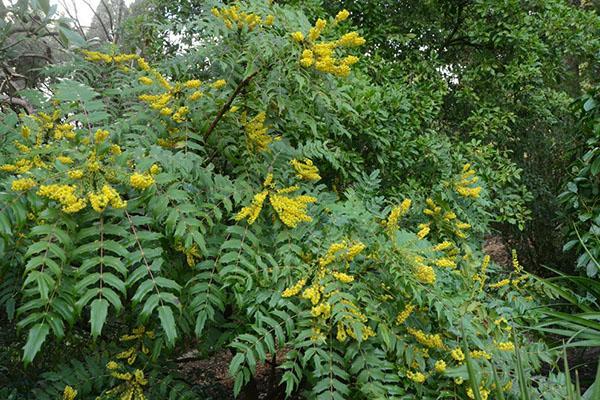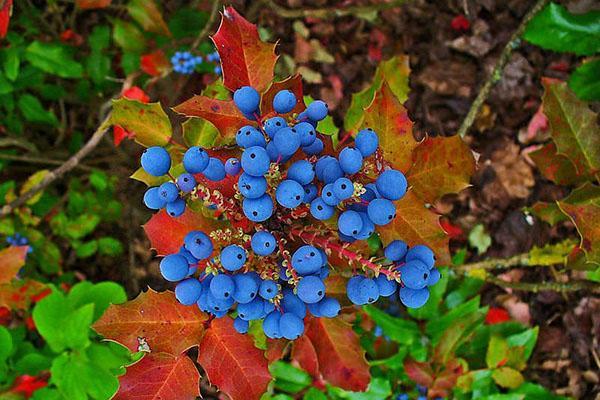Garden decoration - mahonia holly
 Mahonia holly represents the Barberry family. The Latin name for this beautiful shrub is Mahonia aquifolium. This evergreen representative of the plant world is not afraid of cold weather and firmly tolerates snowdrifts. The culture is actively used by landscape designers in the design of various territories. The shrub looks great as a decorative hedges.
Mahonia holly represents the Barberry family. The Latin name for this beautiful shrub is Mahonia aquifolium. This evergreen representative of the plant world is not afraid of cold weather and firmly tolerates snowdrifts. The culture is actively used by landscape designers in the design of various territories. The shrub looks great as a decorative hedges.
Description of the plant

In nature, there are more than 50 types of culture.
The size of Mahonia holly is impressive. She is able to grow up to two meters in height. The plant has very beautiful leathery leaves with a pleasant shine, which delight with their rich green color throughout the warm period, and in the fall change it to an unusual purple-brown hue.
The bushes not only have attractive foliage, but also flowers. In May, the thickets of Mahonia are covered with whole caps of buds of a rich yellow tone, which are collected in inflorescences in the form of a brush. They spread a pleasant aroma, so they constantly circle over the plant bees and other insects. Under good growing conditions, the Mahonia shrub blooms twice a year.
 Lush flowering is replaced by the turn of fruiting. Round berries, blue with a bluish bloom, cover the bush and become an additional decoration for it for several months. The fruits are edible, they are used in medicine to lower blood pressure, and at home they even cook compotes from them.
Lush flowering is replaced by the turn of fruiting. Round berries, blue with a bluish bloom, cover the bush and become an additional decoration for it for several months. The fruits are edible, they are used in medicine to lower blood pressure, and at home they even cook compotes from them.
Since the plant is cross-pollinated, at least two bushes must be planted on the site for the formation of berries.
In landscape gardening, in addition to holly mahonia, the following varieties are popular:
- nut-leaved;
- golden;
- graceful;
- variegated.
They all differ in size and shade of the plates. In Mahonia bushes, golden foliage has a yellowish outline, and motley plates have a white border. Both of these varieties look good when alternating with the holly look.
Mahonia holly: care and cultivation
 The evergreen plant is long-lived. With proper cultivation and care, holly mahonia pleases its owners for many years.
The evergreen plant is long-lived. With proper cultivation and care, holly mahonia pleases its owners for many years.
Landing
 Under natural conditions, this representative of the flora lives in the shade of tall trees and therefore does not like the sun too much. For planting Mahonia holly, it is better to choose a darkened place. Bright sun rays can burn foliage, causing it to lose its attractive appearance and the bush will not grow well.
Under natural conditions, this representative of the flora lives in the shade of tall trees and therefore does not like the sun too much. For planting Mahonia holly, it is better to choose a darkened place. Bright sun rays can burn foliage, causing it to lose its attractive appearance and the bush will not grow well.
The soil
 The composition of the earth is not critical. Bush grows calmly on loamy soils. To plant it, dimples are dug 50 cm deep. The specimens are planted, leaving gaps of one or two meters. The main thing is not to deepen the root collar. Transplanting bushes is allowed at any time of the year, except for the very late autumn, when the plant is preparing for rest.
The composition of the earth is not critical. Bush grows calmly on loamy soils. To plant it, dimples are dug 50 cm deep. The specimens are planted, leaving gaps of one or two meters. The main thing is not to deepen the root collar. Transplanting bushes is allowed at any time of the year, except for the very late autumn, when the plant is preparing for rest.
Watering
 Mahonia holly loves water. It is necessary to water its thickets regularly. To prevent moisture from evaporating so quickly, it is better mulch space around the plant. It is beneficial to carry out systematic spraying of foliage with plain water or special fertilizers.Such foliar feeding will benefit Mahonia.
Mahonia holly loves water. It is necessary to water its thickets regularly. To prevent moisture from evaporating so quickly, it is better mulch space around the plant. It is beneficial to carry out systematic spraying of foliage with plain water or special fertilizers.Such foliar feeding will benefit Mahonia.
Bush trimming
 Shoot pruning is done in early spring before the juice begins to move. Only adults over 10 years old are trimmed. Trimming helps to trim older, heavily overgrown plants. Pruned undamaged branches can be used for grafting.
Shoot pruning is done in early spring before the juice begins to move. Only adults over 10 years old are trimmed. Trimming helps to trim older, heavily overgrown plants. Pruned undamaged branches can be used for grafting.
Best of all, the bush develops in a weak partial shade.
Top dressing
 For a plant to have a healthy and attractive appearance, it is important to systematically fertilize it. You can spray the foliage during the entire warm period with interruptions a month. Root feeding is carried out in the spring. For this, mineral fertilizer of a complex direction is scattered around the trunk directly on the ground.
For a plant to have a healthy and attractive appearance, it is important to systematically fertilize it. You can spray the foliage during the entire warm period with interruptions a month. Root feeding is carried out in the spring. For this, mineral fertilizer of a complex direction is scattered around the trunk directly on the ground.
Pests and diseases
 Mahonia is one of the plants that is quite resistant to diseases, but it is not always possible to completely avoid them. It is most susceptible to the appearance of spotting, rust, powdery mildew. To prevent the development of these ailments, systematic preventive spraying with copper-based preparations should be carried out. For this, a mixture of 200 g of green soap and 20 g of copper sulfate is dissolved in 10 liters of water. Bordeaux liquid is also suitable.
Mahonia is one of the plants that is quite resistant to diseases, but it is not always possible to completely avoid them. It is most susceptible to the appearance of spotting, rust, powdery mildew. To prevent the development of these ailments, systematic preventive spraying with copper-based preparations should be carried out. For this, a mixture of 200 g of green soap and 20 g of copper sulfate is dissolved in 10 liters of water. Bordeaux liquid is also suitable.
Powdery mildew covers the beautiful glossy leaves and shoots of Mahonia with a white coating. To combat this disease, the shrub is sprayed twice a month with Fundazol or Callatan. Products with sulfur in the composition do an excellent job with rust. For prevention, shrubs can be treated in the spring with Tsineb. If rust begins to attack the plates, they are immediately removed to prevent the spread of the disease.
Plant propagation methods
You can get additional plants for the site by cuttings, dividing rhizomes or planting seeds.
Cuttings
 This is the most popular breeding method for Mahonia holly. With the correct procedure, you can grow a beautiful and healthy plant.
This is the most popular breeding method for Mahonia holly. With the correct procedure, you can grow a beautiful and healthy plant.
When propagating Mahonia holly cuttings, it is necessary to take into account the following expert advice:
- only healthy green shoots are chosen for cuttings;
- from below, the planting material is cut obliquely, from above - at a right angle;
- so that the separated branches take root faster, they are treated with stimulating drugs;
- large leaves are removed up to half;
- the cuttings are placed in an earthen mixture, they are buried to the first bud;
- plants are watered and covered with a jar or placed in a greenhouse to accelerate root growth;
- it is important to carry out preventive watering or spraying with fungicides.
Division of rhizomes
 Another popular way to propagate Mahonia holly is with the help of layering. For this purpose, in the spring, the shoots are tilted to the ground, fixed with wire, covered with an earthen mixture so that the top is above it. This way the layers will take root faster. If necessary, they additionally cover the ground with polyethylene and periodically irrigate it. In this state, the shoots are left until autumn. When the roots are well formed, the shoot is cut off from the mother specimen and planted as an independent plant. If the roots are small and undeveloped, I leave the shoots on rooting until spring.
Another popular way to propagate Mahonia holly is with the help of layering. For this purpose, in the spring, the shoots are tilted to the ground, fixed with wire, covered with an earthen mixture so that the top is above it. This way the layers will take root faster. If necessary, they additionally cover the ground with polyethylene and periodically irrigate it. In this state, the shoots are left until autumn. When the roots are well formed, the shoot is cut off from the mother specimen and planted as an independent plant. If the roots are small and undeveloped, I leave the shoots on rooting until spring.
Seed method
 This is a more difficult type of reproduction. Growing Mahonia holly from seeds is carried out both in autumn and in spring. The seeds are preliminarily kept in the refrigerator for at least three months. For autumn sowing, this procedure may not be carried out, but sow them well in advance of the onset of frost. The seeds are deepened by only 1.5-2 cm.
This is a more difficult type of reproduction. Growing Mahonia holly from seeds is carried out both in autumn and in spring. The seeds are preliminarily kept in the refrigerator for at least three months. For autumn sowing, this procedure may not be carried out, but sow them well in advance of the onset of frost. The seeds are deepened by only 1.5-2 cm.
Another option for obtaining a new shrub is to cut off several shoots in winter and put them in a jar of water. Keep them in a bright, warm place. After a couple of months, the twigs take root. Instances that have remained the same need to be dug in the spring on the site.
Magonia in the suburbs
 Adult plants are not at all afraid of cold weather, they tolerate wintering well. Therefore, in the Moscow region, holly mahonia takes root and does not require specific care. The main thing is to protect young specimens in the first two years of growing.
Adult plants are not at all afraid of cold weather, they tolerate wintering well. Therefore, in the Moscow region, holly mahonia takes root and does not require specific care. The main thing is to protect young specimens in the first two years of growing.
Previously, the plant was used to dye fabrics in a yellow tint.
For this you need:
- In mid-autumn, the shrubs spud, sprinkling the trunk circle well with earth. The higher you fill it with soil, the better it will be for the plant.
- For wintering, shrubs of Mahonia are covered with spruce branches. Instead, you can fill the trunk circle with a good layer of any dry residues. For these purposes, ordinary straw, hay, pine needles are suitable. This will protect the young root system from freezing.
- In severe frosts, drifts of snow are applied to the bushes, creating a protective "fur coat" for them. If winter is not very fierce, you don't need to do this.
- After the snow melts, the planting is freed from spruce branches or mulch. As it warms up, the ground around the bush is leveled.
Due to its exceptional unpretentiousness, Mahonia is a versatile plant on the list of landscape designers. With the help of its flowering shrubs, you can make a hedge, place it on a hill with stones, or plant it separately. Mahonia is combined with many plants in compositions. It looks especially good in a company with barberries, roses, Japanese quince or primroses. Plant Mahonia on your site, it deserves this, as well as proper, caring care.
Magonia in landscape design in the photo:




